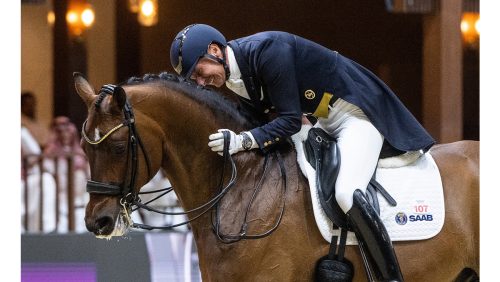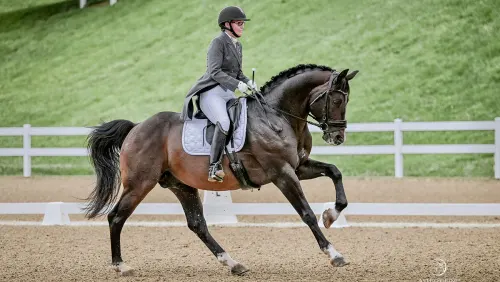With a USDF gold medal earned on her Arabian gelding, she shows neither age nor breed are a barrier to accomplishing great things.
It’s not very often that you hear about an 18-year-old earning her U.S. Dressage Federation gold medal. Throw an Arabian gelding and North Dakota into the mix, and you’ve got Mimi Stanley.
“I don’t remember not riding,” said Stanley, who rode in leadline classes at age 3 and entered her first dressage show at age 6 aboard her mother Karla’s childhood pony, Snuff.
Karla’s father, however, was the man who brought Arabians into the family. He purchased four Arabian broodmares during Karla’s childhood, and raising the breed quickly evolved into a life-long endeavor.
Mimi began showing Arabians because they were available at the time. She competed in a little bit of everything as a child but enjoyed the precision and fine-tuning required by dressage.
“From the first time I met her, Mimi has been incredibly driven, dedicated and focused,” said Amy Larson, one of Mimi’s long-time trainers. “She has an innate sense of balance and timing that she seemed to come to this earth with. There are so many things that most riders must struggle to understand, skills they must learn to feel, that take years to hone and fully implement. Mimi seemed to grasp many of these skills and concepts, as though she had done them before.”
As Mimi aimed toward riding upper level dressage, she and her mother realized that she needed a schoolmaster to help her rise in the ranks.
A Fortunate Find
EA Cygnus+// came to Mimi’s attention in the fall of 2004 when she was flipping through the pages of an Arabian magazine and saw an advertisement featuring a stunning 1990 gray gelding with Grand Prix experience.
“I showed it to my mom, and she was distracted, so she just told me to call,” said Mimi. “I spoke to his owner and, although I shouldn’t have been surprised, I was a bit put off by the price. But Mom said to ask for a video, so we did.”
At the end of March the Stanleys made the 3,400-mile drive to Louisiana to pick up “Cygnus.” “I was so nervous and excited,” said Mimi. “I held this horse in higher regard than any movie star.”
Mimi and Cygnus got along well from the start, but it wasn’t always easy.
“Cygnus is not really a generous or kind schoolmaster,” said Karla. “He’s spooky, and he has a big shy in him.”
Cygnus enjoys “recreational spooking” and often rockets across the ring on two legs. “He’s arrogant and thinks he knows everything,” said Mimi with a laugh. “If you think differently, too bad for you. It’s a bit trying at times, but I think in order to do Grand Prix a horse needs a little bit of that fire. I always remember that Conrad Schumacher said, ‘A Grand Prix horse is a controlled explosion.’ We work on the controlled part.”
“Cygnus is a giant personality in a smaller-sized package,” said Larson. “He will deliver 200 percent to the effort, as long as his personal boundaries are respected. Cygnus’ sense of fairness is inviolate.”
ADVERTISEMENT
Mimi and Cygnus made their debut in mid-May of that year at third level. “What stands out most about the show is that his tail got caught on the edge of his saddle pad,” said Mimi. “We did half-steps in place of our canter transition, and the judge’s comments said, ‘You do not get extra points for piaffe.’ ” They finished the year with a few nice tests at fourth level and Prix St. Georges.
Some Setbacks On The Road To Gold
In 2005, Mimi continued showing Cygnus in the small tour classes and started earning the scores she’d need for her gold medal.
“I decided the night before the last day of a three-day show that I would change my entry to Grand Prix,” said Mimi. “I’d never ridden the test and didn’t know it, but Cygnus was game as always. Looking back it seems a little crazy, but everything we did at the time was new to us, and he’d gotten used to that. But there is a lot of ground between a Prix St. Georges and a Grand Prix horse, even if the horse had been there once.”
“Mimi’s determination makes her a bit like a guided missile,” said Larson. “She is deliberate in her approach, confident in her expectations and always assumes that the very best possibilities are within reach. Her horses mirror her attitude with a positive flair and great energy. My job has been to sometimes slow her down.”
Mimi and Cygnus competed at Grand Prix a few more times that year, receiving one score over 60 percent. The excitement about her upcoming season quickly fell short, though, when one day Cygnus wouldn’t walk out of his stall. A six-hour drive to lameness specialist Tracy Turner in Minnesota followed, where he was diagnosed with laminitis caused by Equine Metabolic Syndrome.
Similar to Type II Diabetes in humans, EMS is mainly due to insulin resistance and affects overweight horses between the ages of 8 to18. Cygnus had put on a slight amount of weight, and his exercise was less intense over the winter—and that was enough. Fortunately, the Stanleys caught the laminitis before there was any permanent damage.
“We now have him on a low carbohydrate diet and keep him very slim,” said Mimi. “It can be challenging to give Cygnus enough exercise, because he plays too hard during turnout and hurts himself. It makes winter riding hard, but we do a lot of conditioning basics.”
In early spring, Mimi took Cygnus to train with Schumacher in preparation for a season of Grand Prix, but she noticed that he seemed tense. A few days before a show, he started rearing in passage.
“We were very worried and backed way off his workouts,” said Mimi. “At the show, he seemed fine in the warm-up, so down centerline we went. At A, Cygnus spooked, came against the bridle, reared and bolted. He was really upset and seemed terrified.”
They were dismissed from the ring with no idea what went wrong.
It turned out that because Cygnus had been in the clinic due to his EMS, he had missed his six-month dental work, resulting in sharp edges on his back molars that cut his palate.
“They were only a problem when his jaw alignment changed with collection and flexion,” said Mimi. “It was a hard lesson to learn, and I had a sore, unfit horse that didn’t trust the bridle anymore.”
Mimi’s goals for that season were quickly abandoned and replaced with rehabilitating Cygnus. “We worked twice a day but very slowly,” said Mimi. “First in a halter while his mouth healed and then in his snaffle. I rode him in a first level frame and gradually put him deeper. It was a slow process getting him fit, but the hardest part was convincing him to trust.”
After graduating from high school a semester early, Mimi took Cygnus to Tempel Farms in Old Mill Creek, Ill., for a working student position. It was the ideal place to continue Cygnus’ training due to the help of Jochen Hippenstiel and his wife Sarah.
“They made themselves available to help us almost every day,” said Mimi. “He focused on Cygnus’ work being quiet and correct but very available. We would do things like go from walking on a long rein to perfect two-tempi changes. It was just what Cygnus needed.”
ADVERTISEMENT
Mission Accomplished
Mimi entered four Grand Prix tests with Cygnus in her first show of 2008. “I know it’s unorthodox to do that many tests,” said Mimi. “But that’s the beauty of having a really fit Arabian.”
Mimi only needed one score for her gold medal and was focused on that accomplishment. A USDF gold medal requires two Intermediaire I or Intermediaire II scores and two Grand Prix scores. Each score must come from a different ride and a different judge.
“I was nervous about the test since it was my first Grand Prix ride of that year,” said Mimi. “The ride went well, it was a clean ride, but I didn’t know for sure [if I’d earned the score I needed]. I wasn’t positive.”
Mimi was walking back to the office when a friend grabbed her and pointed to her score on the board. “I think I squealed and turned in circles or something. It was more of a relief than anything else. I remember the second test I rode with Cygnus that day better, because I was riding for me and not my gold medal. It was a celebration ride, but more importantly I had a sound and happy horse,” she said.
Cygnus also completed his Horse Achievement Award for Grand Prix, with 10 scores of 60 percent or above at each level, from four different judges and four different competitions. In addition, he was the 2008 Adequan/USDF Junior/Young Rider Grand Prix Horse of the Year and the All-Breeds Junior/Young Rider Grand Prix Horse of the Year.
When Mimi received her gold medal in December, Karla also received her bronze medal, making dressage a true Stanley family sport.
“People have been so generous with their time and information,” said Karla. “You don’t see Arabians very much, but what Mimi has done proves you don’t have to have the ideal image of what a dressage horse is to be successful.”
She’s Looking Forward
Although Mimi was thrilled with her achievement, she knows that Arabians won’t be her ticket to international competition. However, she does hope to take Cygnus to the Brentina Cup, a Grand Prix competition for young and aspiring professionals.
“Arabians are well accepted, but there’s still a stigma. If a warmblood comes into the ring, a judge may think, ‘This will be a nice test.’ But if an Arabian comes in and looks just as nice, a judge may think, ‘We’ll see,’ ” said Mimi. “You have to be correct and prove it. Some of the dressage movements are just naturally harder for the Arabians because they aren’t bred to be dressage horses.”
But it doesn’t stop her from working with them. Mimi competed two half-Arabians, Starfires Orion+ and PR Captain Hook+/ at the lower levels. She also plans to campaign the 3⁄4 Arabian pony mare, PR Merrylegs+// at fourth level in 2009.
In the wings, Mimi has a Lipizzaner mare that she’s training for Tempel Farms and a young Arabian stallion.
In the meantime, she is continuing her education at Bismarck State College (N.D.), where she’s majoring in equine studies and minoring in business.
“At times it’s very daunting being Mimi’s parent because of her personal drive,” said Karla. “She has a single-minded determination and is so serious about what she wants. Her work ethic is wonderful, and trying to provide her with the right opportunities has been something else. As a family, we’ve really taken on the attitude of ‘Why not?’ ”















